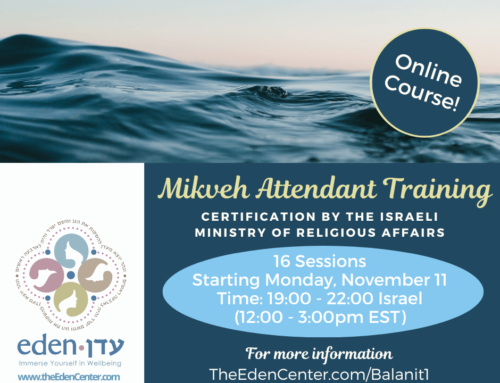 Women immersing on Erev Yom Kippur– What are you talking about?!?!
Women immersing on Erev Yom Kippur– What are you talking about?!?!
There is a tradition of women immersing in the mikveh before Yom Kippur for the sake of spiritual preparation for Yom Kippur. This is a way to “purify” one’s body in preparation for the holiest day, just as men do. Though we remain halakhically impure, it gives a time for spiritual focus and tefilla. It is completely unrelated to one’s niddah status and allows for us to experience the mikveh as a spiritual center.
Who can go?
Because this is just a minhag, many poskim believe that anyone can go– young and old, single and married, niddah and tehora. (Similar to the attendance of all men and boys on this day).
- The Mishneh Berura and the Ben Ish Hai expressly write that married and single women should immerse.
- Rav Ovadia Yosef and other contemporary Poskim oppose singles and women during their 7 “clean days” from immersing Erev Yom Kippur. Those prohibiting it do so mainly to prevent a woman feeling that this immersion removes her niddah status (or the need for the 7 clean days); other reputable poskim allow all women to immerse since it is unrelated to niddah.
- Some women find immersing in a mikveh while bleeding inconceivable, and they don’t. They can follow the recommendation of the Pninei Halacha to take a long shower with 11-13 liters of water and to ensure that the water covers all parts of the body.
The Eden Center finds it a wonderful opportunity to introduce the mikveh to your daughters in a spiritual yet non-sexually focused format. Girls should be accompanied by their mothers and can wear a bathing suit if they feel more comfortable that way.
Do people really do this?
In Hasidic circles, for sure! There are lines around the block at those mikvaot. More and more women are embracing and loving this connection of their spiritual life to the mikveh.
What are the differences in the actual tevilla?
- There is no need to prepare the body or remove hatzitot (no iyun, nail filing, soaking, checking for hairs or any other…) When she arrives at the mikveh she can go straight in.
- She does NOT say a bracha on her tevilla.
- There is no need for a balanit.
How many times do I dunk?
The common suggestion is 3– some reasons for this are the comparison to a convert who dunks three times, and the literary mention of taharah 3 times in pesukim related to Yom Kippur. (see sources below)
My mikveh isn’t open on Erev Yom Kippur for women. What can I do?
- Let the attendant know that you would like this opportunity and perhaps they will open for an hour or so– and if not this year, then plan ahead for next year
- Go the night before during regular opening hours and tell the attendant that you are there for taharat Erev Yom Kippur (and don’t need a shower or for her to check your body)
- Take a long shower as suggested by Pninei Halakha source below
What is the source of this minhag?
Rav Amram Gaon already speaks about women immersing in a mikveh on Erev Yom Kippur and it is a custom that was adopted by Sefer HaChasidim. It’s not clear from the early sources if it’s for teshuva, taharah, to be similar to angels or sexual purity but whatever the source, it’s not a halakhic requirement but a spiritual sort of preparation for Yom Kippur.
What other information is there on this custom?
Here are several other posts on the topic:
Tefillot Before your Erev Yom Kippur Tevilla
Reflections on my First Tevilla on Erev Yom Kippur
A Total Cleansing: the Mikveh before Yom HaDin
Intimate Teshuva: Using the Spiritual Tools of Aseret Yemei Teshuva
And in the Forward:
Orthodox Women Dare To Go To The Mikveh On Yom Kippur Eve — Like Men
Who can I call for more questions?
Judith Fogel, Yoetzet Halakha, 0547488987
Gmar Chatima Tova!
: משנה ברורה : חלק ו’ סימן תרו סעיף קטן יז
בתולות מכיוון שהם בנות מצות טובלות בערב יום כיפור.
הנה ענין הטבילה בערב יום הכיפורים כבר מובא בראשונים
אין גם חובה לטבילה זו ואין לברך עליה
והנה נחלקו הפוסקים אם סגי בטבילה אחת , או בעי ‘ ג’ טבילות , דיעוי ב ‘ דרכי משה ( ישד ‘דכ )ג, תרו אומרים שהוא משום טהרה “וע כ די בפעם אחת, ויש אומרים שהוא משום תשובה כגר המתגייר שהוא טובל ולכן צריך לטבול שלש 1 טבילות כ”וכ, הרוקח ו, בשלה ( ק” מסכת יומא עמוד התשובה ) ובמג ( א” )ט ,תכז ובאלף ( ןהמג סימן ).טו ,תכו ןוכ ‘ בס כתב חסידים ( סימן תתשפב , ל”וז) הטובל בעיו כ” יכניס את ראשו ‘ ג פעמים .כ”ע והובא במשנה ברורה שם( [ .)א
וכן לטעמו של הספר חסידים ‘ סי( )שצד שהנשים רגילות לטבול שלש פעמים , כמוכח בקרא ( יחזקא ‘ )כה ,לו ל וזרקתי עליכם מים טהורים וטהרתם אטהר אתכם ‘ שהוזכר בו שלש פעמים טהרה יעו [ ,ש” והעירו דה”ה ביו”כ נזכר שלשה פעמים לשון טהרה , בפרשת אחרי )יט ,טז( מות וטהרו וקדשו מטמאת בני ישראל כי )ל ,טז( וכן , ביום הזה יכפר עליכם לטהר אתכם ‘ כו ‘ ה לפני תטהרו ‘ אולככ “או, ]
פניני הלכה
רבים נוהגים לטבול בערב יום הכיפורים, כדי לטהר עצמם לקראת יום הדין, וגם משום תשובה, אבל אין מברכים על טבילה זו הואיל והיא מנהג בלבד (שו”ע תרו, ד). מי שרוצה לקיים את המנהג אבל קשה לו ללכת למקווה, יכול לרחוץ בט’ קבין (רמ”א שם). היינו שיעמוד במקלחת עד שיזרמו עליו מים ברציפות כשיעור של ט’ קבין, שהם כ-11-13 ליטר, ויקפיד שמים אלו ירחצו את כל גופו (פנה”ל מועדים א, טז, 8). בעבר גם נשים נהגו לטבול לקראת יום הכיפורים, וכיום אין כמעט מי שנוהגת כך.







” Those prohibiting it worry that a woman during her 7 clean days will get confused about her niddah status” what an insult to the basic intelligence of women.
I think I would phrase it more as “might feel it’s halakhically sanctioned to cut the 7 clean days short” — and thank you for the sensitive reading – so will change that language.